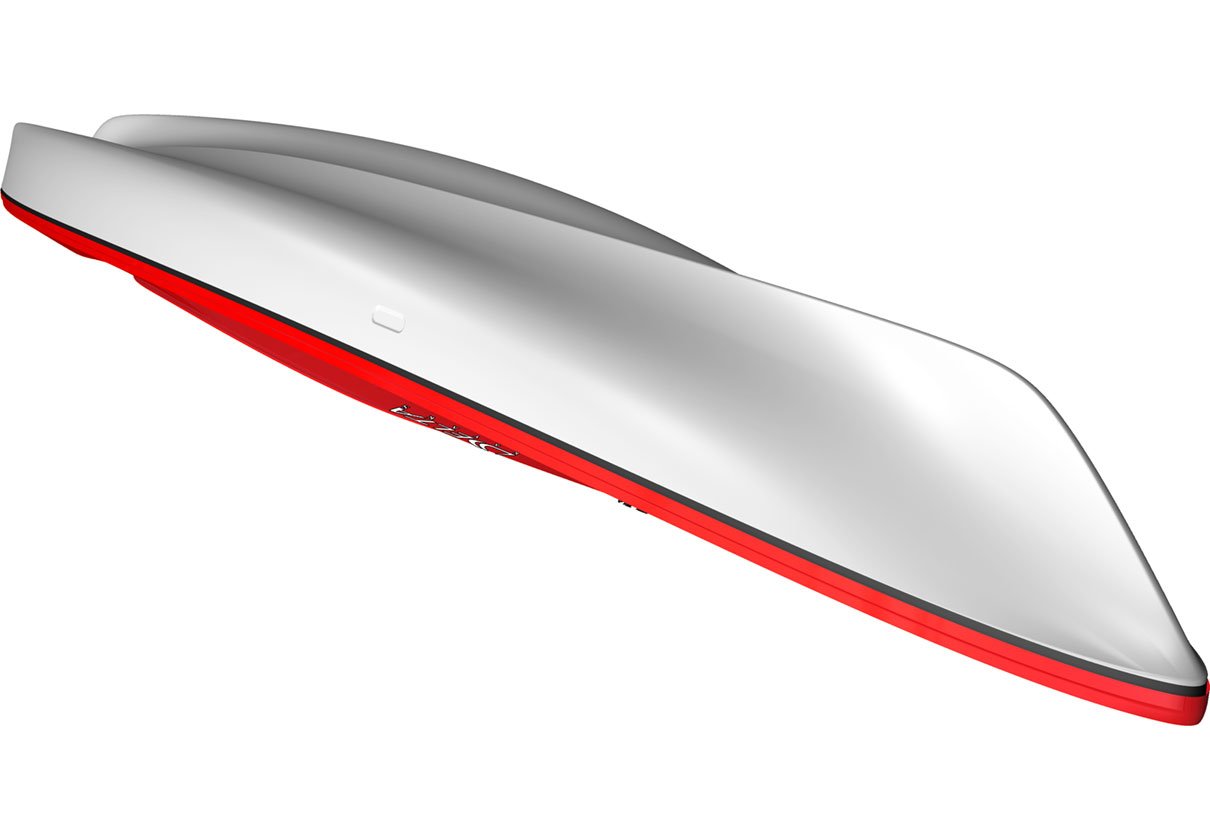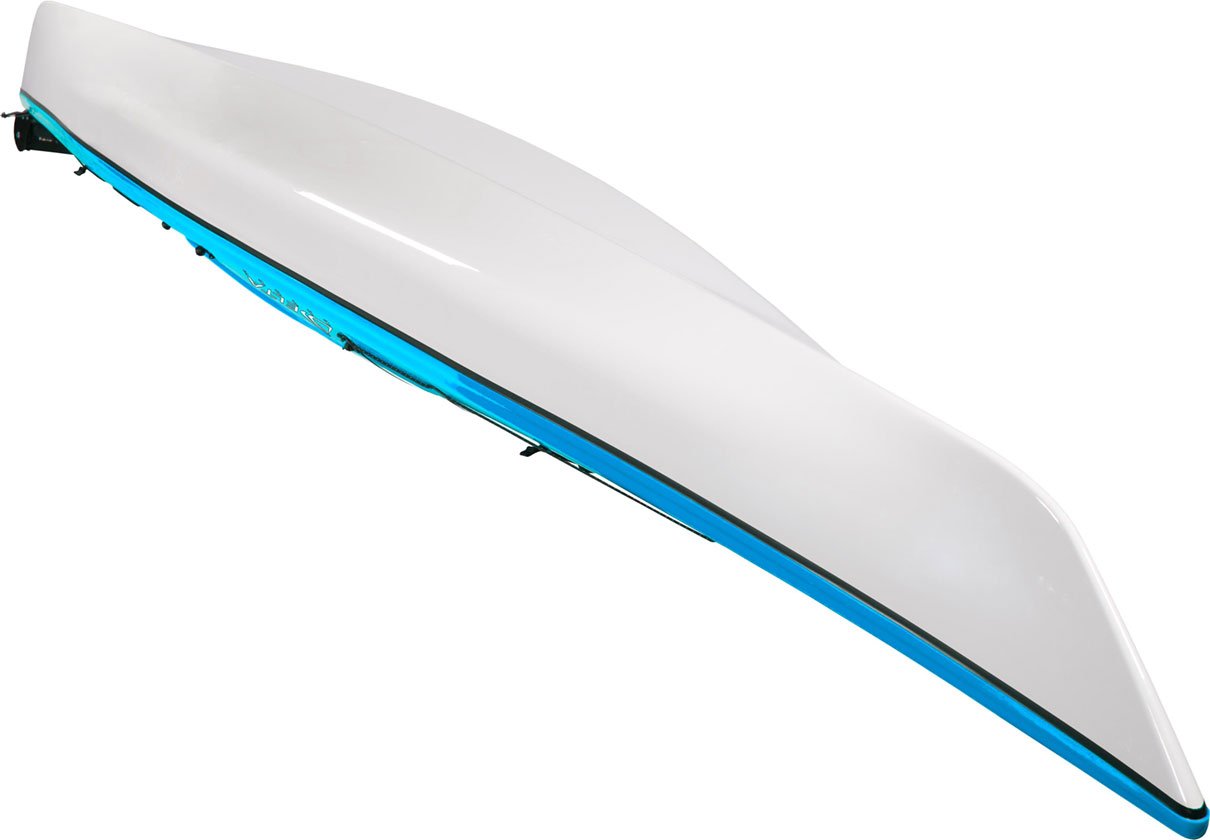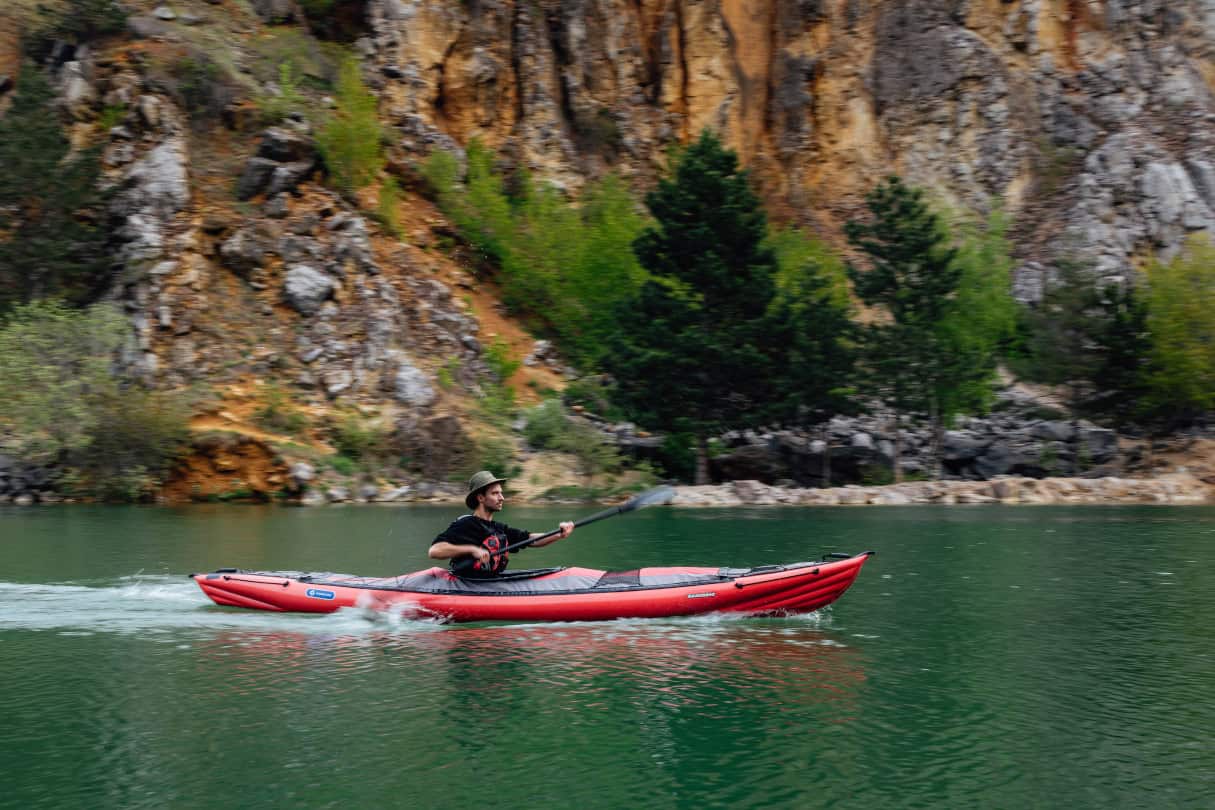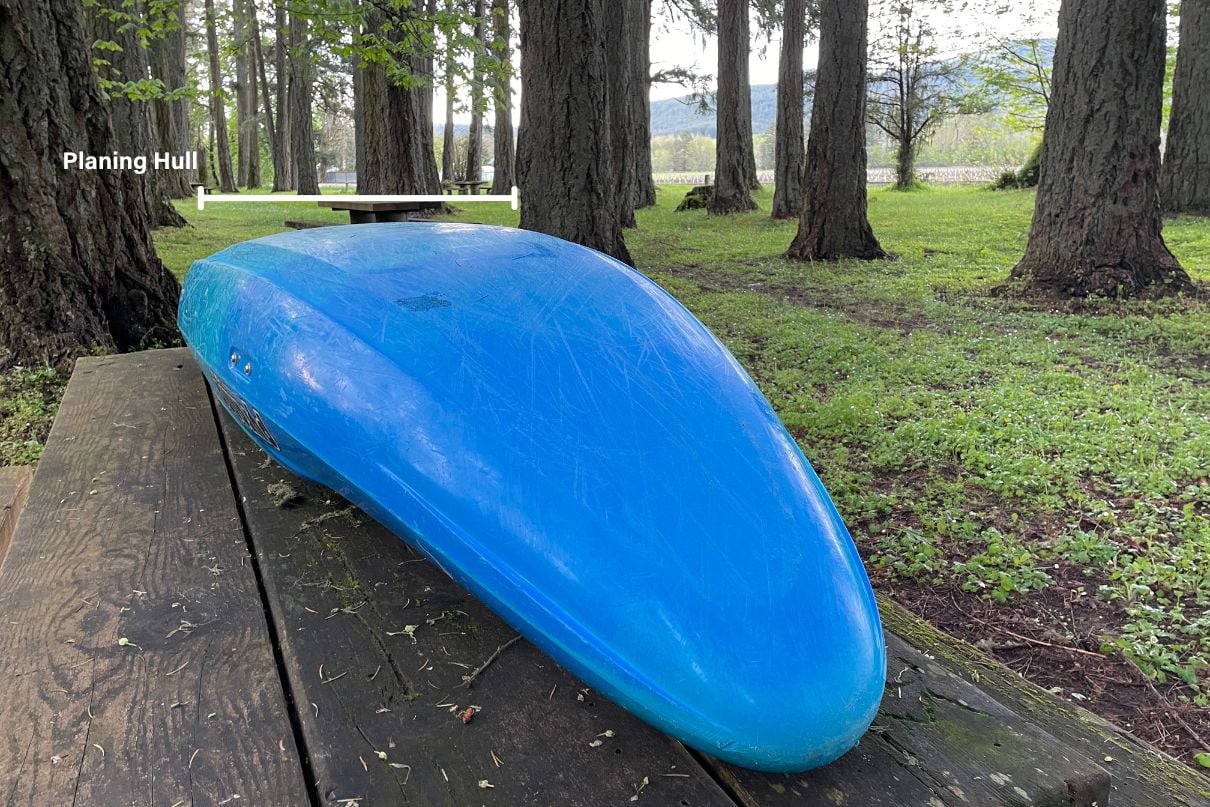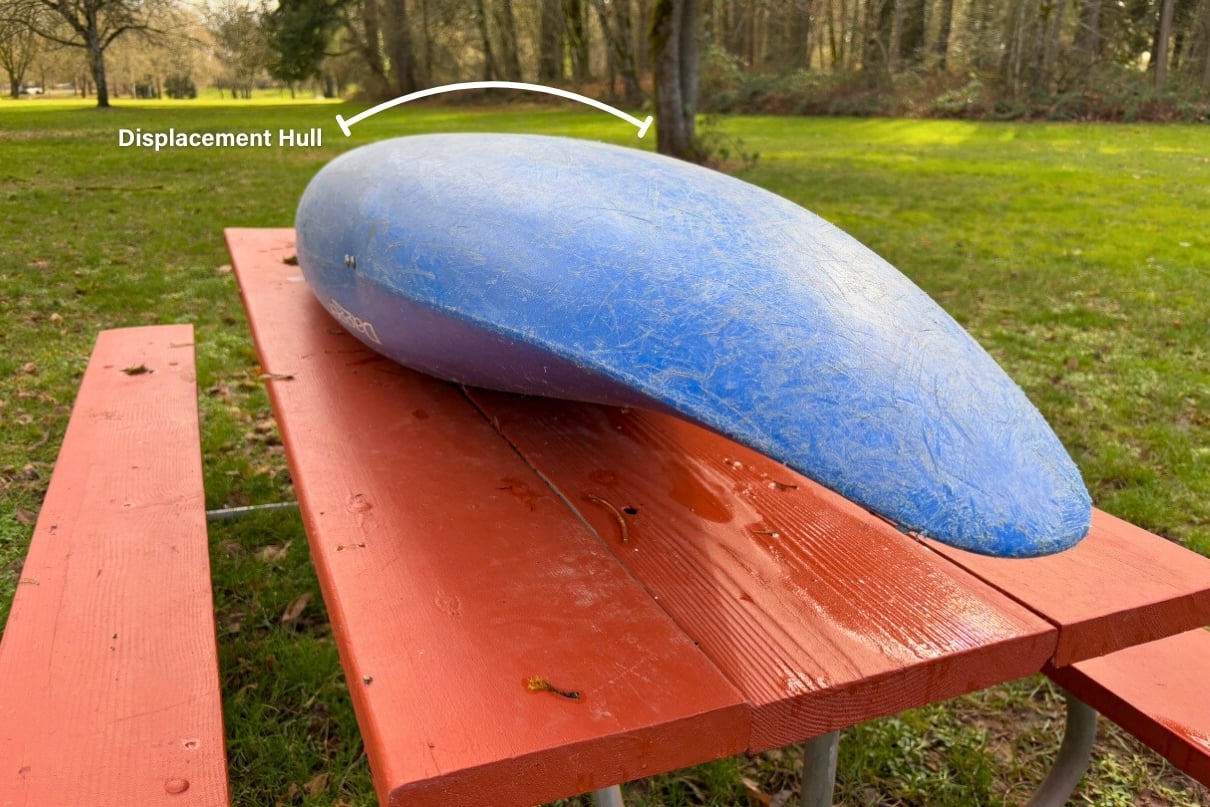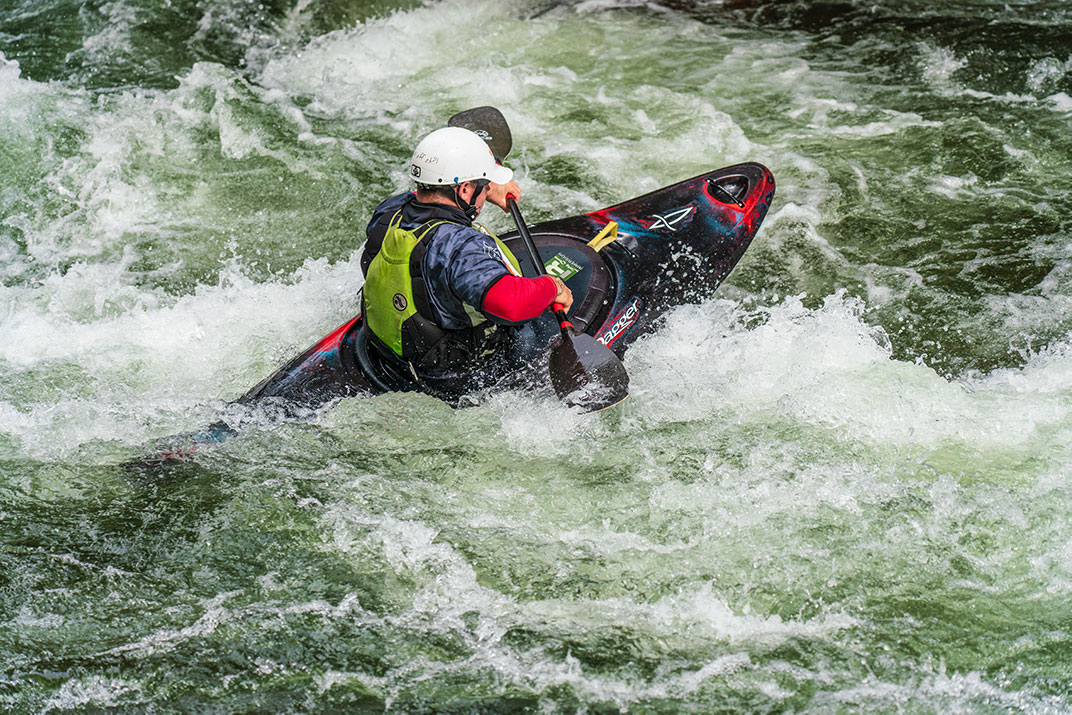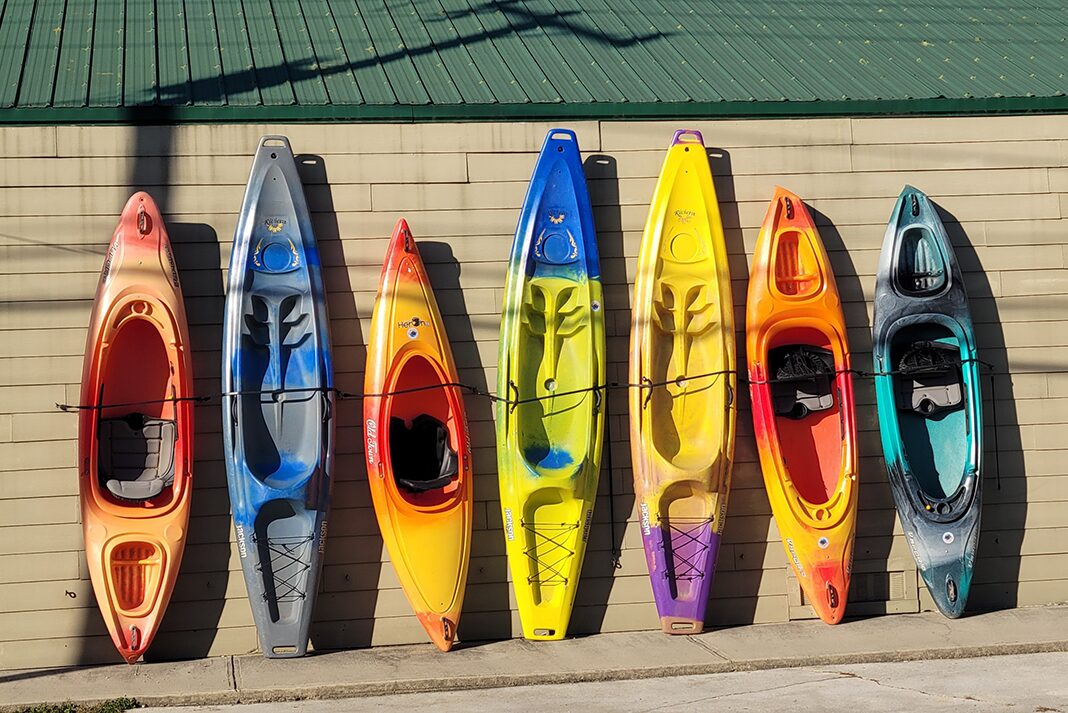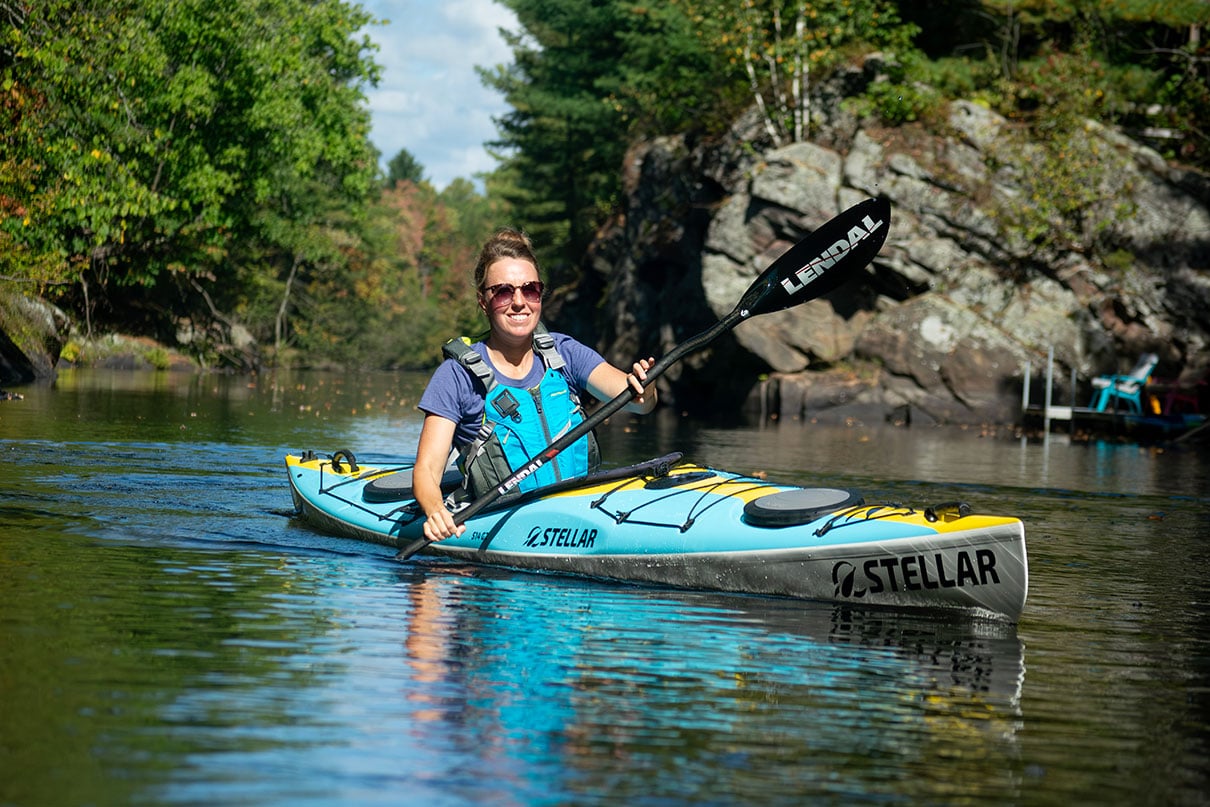There are many different types of kayaks, but each kayak’s performance is ultimately determined by the shape of its bottom and how these curves (or “lines,” in nautical terms) interact with the water to influence characteristics like glide, stability and maneuverability. This article describes why hull types are integral to performance and investigates the attributes of different shapes you’ll find on recreational and touring kayaks.
What is the hull of a kayak?
The bottom of a kayak is called the hull. This “floating surface” forms an interface between the kayak and the water, and thus plays a primary role in determining how the boat will perform. Ultimately, the design of the hull of a kayak is the main factor in whether or not a kayak is right for you.
An educated buyer can look at a hull design and estimate how the boat will perform in the water. Different kayak shapes will have different paddling characteristics; speed and glide, tracking and maneuverability, and stability are all directly influenced by these shapes.
In general, hull design boils down to a few things: First, rocker, or upsweep of the kayak from bow to stern, establishes the balance between tracking and maneuverability. For example, whitewater kayaks feature plenty of rocker to assist agile handling in rapids, while sea kayaks have minimal rocker to enable easier straight-line travel (A.K.A. tracking).
Another are the chines of the kayak, which mark the transition from the bottom of the kayak to its sides. Chines, also referred to as edges, play a role in the way in which the kayak turns, and in how stable it feels to transition the kayak from flat on the water to leaning one way or the other.
Finally, the cross-section of the hull (as if a slice were taken from the kayak from side to side) is interrelated to the other elements and also creates numerous design options. The design of the bottom of your kayak influences speed, stability and turning. To help understand the different kayak hull types and which will be the best kayak for you, let’s take a look at the details of the major styles.
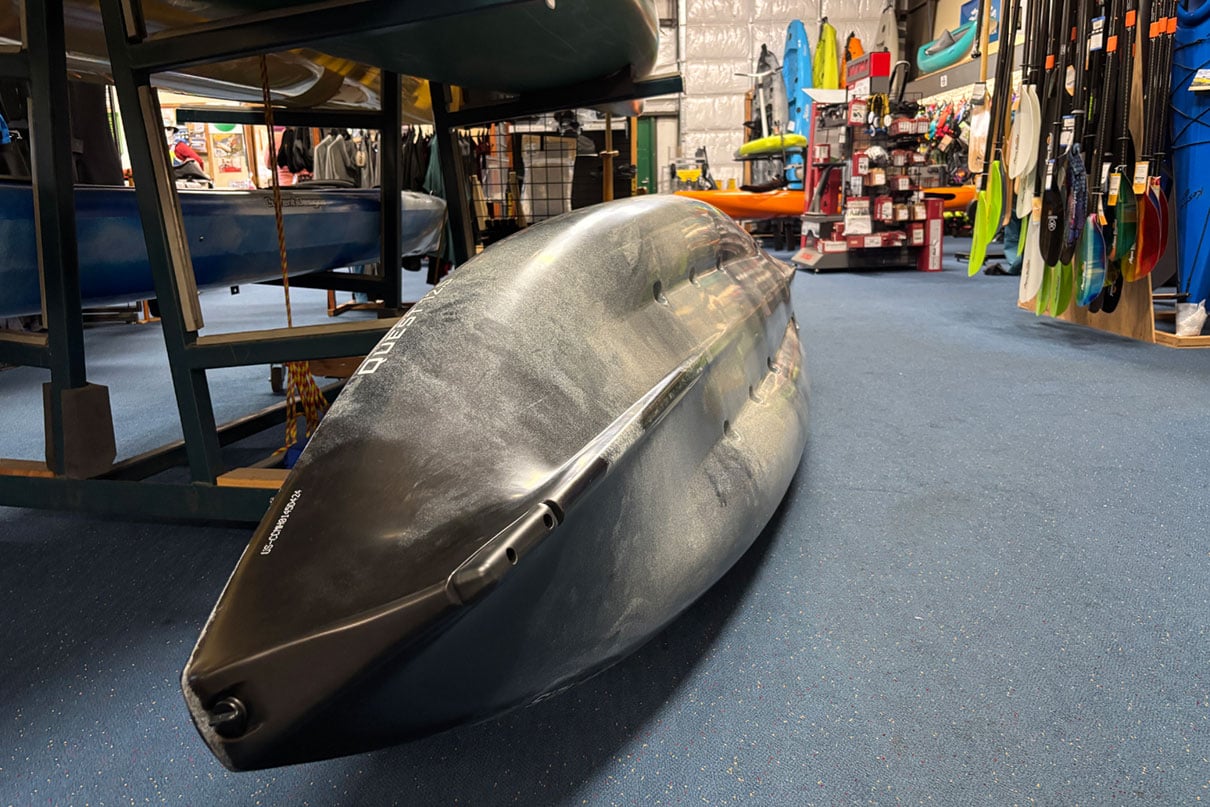
Kayak hull types
Multi-hull designs
Pontoon hull kayak
This type of hull is often also called a “double hull kayak,” “tunnel hull,” “dual hull design” or “catamaran hull kayak.” They prioritize stability, at the expense of speed and maneuverability. Like a pontoon boat, a pontoon hull kayak is designed to sit flat on the water and resist rocking from side to side. It’s a common kayak design for beginner sit-on-top kayaks. The large surface area of this hull type makes it slower to accelerate and requires more effort to maintain a cruising pace.
Pontoon hull kayaks track well; that is, they tend to move straight through the water and are more difficult to turn. Choose a pontoon if you’re a beginner paddler looking for the ultimate in stability. However, be aware that this type of kayak design will also limit your ability to perform more advanced paddling techniques, such as edging the kayak (which increases maneuverability in single-hull kayaks).
Tri-hull kayak
This type of hull is often also called a “cathedral hull kayak,” “kayak dihedral hull design,” or “multi-channel hull kayak.” This type of bottom is commonly used for sit-on-top kayaks (especially those manufactured by Ocean Kayaks). A tri-hull kayak provides the reassuring stability of a catamaran hull with the enhanced tracking of a well-defined keel line—that is, a V-like structure running along the bottom of the kayak from bow to stern.
Manufacturers of tri-hull kayak designs can also achieve more maneuverability than pontoon kayaks by adding rocker (curvature) to the outer hulls, which allows the kayak to turn more easily yet still feel supremely stable. Look for a tri hull design if you want a higher performance beginner sit-on-top kayak.
Flat and planing hull kayaks
Flat hulls on recreational kayaks
A flat hull or planing hull kayak is defined by great stability when sitting on flat water. That’s because the paddler is effectively floating atop a larger, flat surface that resists rolling from side to side in the water. Flat bottom kayaks are commonly used on recreational kayaks. This hull design is often paired with a wider-than-average width, to further enhance stability and support larger paddlers. Flat bottom kayaks feel most stable on flat water, a phenomenon known as “primary stability.”
However, they can feel tippy and less reassuring to the paddler when waves or current rock the kayak from side to side. In these circumstances, flat bottom kayaks are said to have poor “secondary stability,” and are more prone to capsizing than kayaks with rounded hulls. Flat hull kayaks also tend to be slower on flatwater because their boxy shape moves through the water with greater resistance than rounder hull designs.
Whitewater kayaks and planing hulls
A flat hull on a whitewater kayak is often referred to as a planing hull, a common term in boat design. Again, planing hulls provide great initial stability, but whitewater kayakers also value them for other characteristics. For example, they are maneuverable in rapids because the large flat surface lets the kayak spin to change direction easily.
Whitewater freestyle kayaks—small, sub-seven-foot-long kayaks meant for surfing on stationary river waves—feature these flat-bottom, planing hulls, which allow an advanced paddler to “skip” on the surface of the water to perform acrobatic maneuvers. Many modern river running kayaks also value the “skip” of planing hulls to carry them over river features as the kayak is traveling at faster speeds in swift currents.

Round and displacement hull kayaks
Recreational, touring and sea kayaks often feature what’s known as a “displacement hull.” This means the kayak pushes (or displaces) water as it moves. This is in contrast, to the planing hull, often identifiable by a flat bottom which will plane or skip across the water with minimal resistance—once it reaches a certain speed.
In contrast to a flat bottom, a round or displacement hull kayak has greater secondary stability. Touring kayakers value this because it is more resistant to being capsized in waves, chop and current because of the round hull that lets waves pass along.
However, a round hull has far less primary stability and feels “tippier” when sitting flat on the water. In actuality, displacement hulls are stable, but the boat is designed in a way that it has more contact with the water when it is leaned toward one side or another—what is called secondary stability. If you don’t trust the boat, your hips tense up, and because of that, you can self-fulfill the prophecy and potentially flip. Much like riding a bike, a displacement hull feels stable when you’re moving. Therefore, round designs are less popular with beginners.
More advanced touring and sea kayaks tend to have rounder hulls, and, when combined with more length and narrower width, makes them faster in the water than flat-bottom kayaks.
V-hull kayak
A V-hull kayak features a pronounced keel line (that is, a shallow V-shaped ridge running from bow to stern along the bottom of the kayak). This allows the kayak to hold its course (or track) better than a flat bottom kayak, since the V-shape of the keel line resists turning more than a flatter hull. This attribute makes V-hulls a valued design for touring kayaks. The flipside to solid tracking, however, is reduced maneuverability.
More advanced paddlers overcome this tendency by performing turning strokes with the kayak tilted (also known as edging the kayak) to lift the V-shaped keel out of the water. V-shape kayaks feel less stable when sitting flat on the water, with a tendency to rock from side to side. However, this translates to greater stability in waves and current—another desirable attribute for more advanced paddlers.
Comparing different hull types
-
Flat bottom vs V-hull kayak
There are two main differences between flat bottom and V-hull kayaks: tracking and stability. A V-hull kayak will tend to hold its course (or track) better than a flat bottom kayak, since the V-shape of the keel line resists turning more than a flatter hull. Meanwhile, a flat-bottom kayak will feel more stable on the water than a V-bottom, which has a tendency to rock from side to side on flat water.
However, the stability characteristics of flat bottom and V-hull kayaks are opposite in waves, chop or current: in these conditions, a V-hull kayak will feel more stable and resistant to capsize than a kayak with a flat bottom. In general, V-hull kayaks are more efficient to paddle, with better speed and glide than flat bottom kayaks. V-hulls are typically associated with more advanced kayak designs while flat bottom kayaks are more suitable for beginners and flatwater conditions.
-
Planing hull vs displacement hull
The question of planing hull vs displacement hull is regularly brought up in conversations surrounding whitewater kayaks. A planing hull whitewater boat has a flat surface area that feels initially stable and, for advanced whitewater boaters, allows the kayak to skip and spin, whether that be while going down river or surfing standing waves in rapids. This is also referred to as a loose hull. Freestyle kayaks and river running kayaks often have a form of planing hull.
In contrast, displacement hulls have typically been used on river running kayaks and creek boats. This shape tracks in a path easier and is said to be forgiving as it lean from edge to edge—but they are less suitable for uses such as performing freestyle maneuvers.
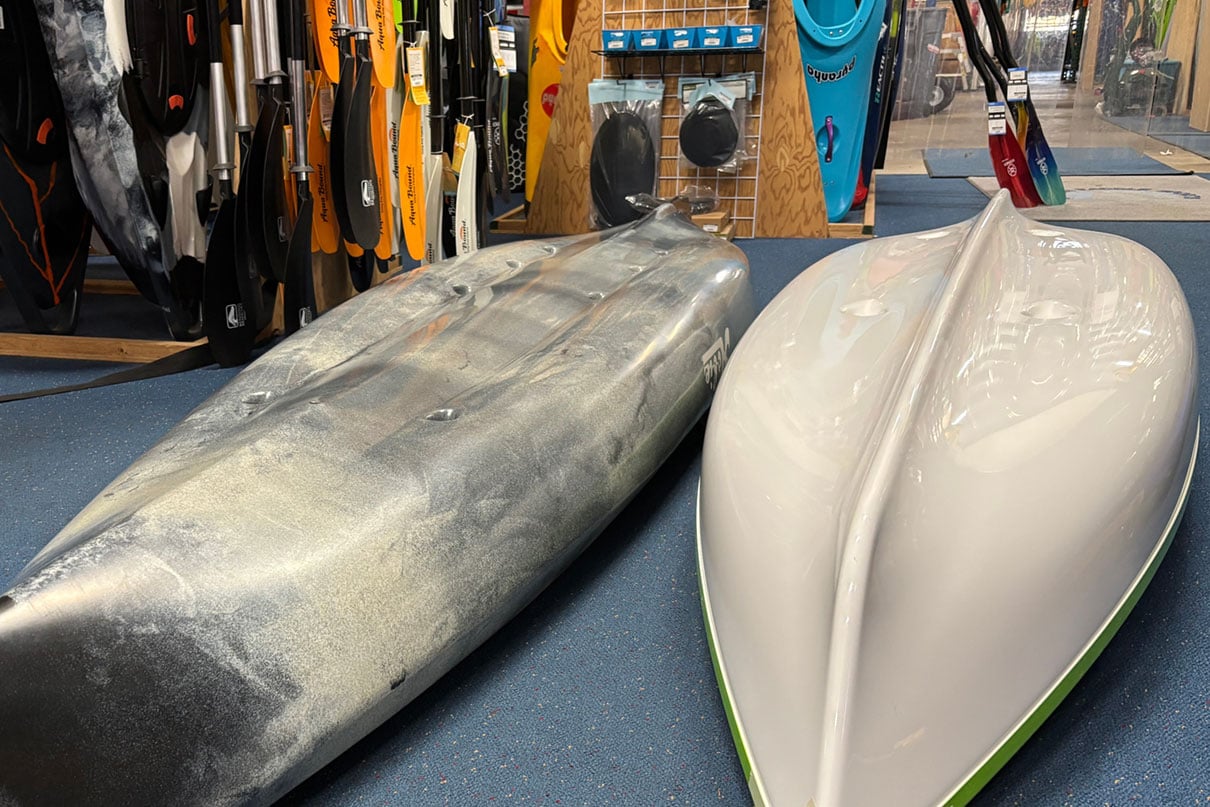
Hulls choices for different kayaks
Recreational kayak hull design
Recreational kayaks are made for beginners, and stability is the primary objective of their design. In this category of kayak you’ll find flat bottom hulls for maximum stability and comfort in flat water conditions. Some manufacturers further enhance stability with pontoon or catamaran designs. Sit-on-top kayaks often feature tri-hull (also known as “cathedral hull kayak,” “kayak dihedral hull design” or “multi-channel hull kayak”) designs that are both stable and extremely easy to paddle in a straight line.
The large surface area of recreational kayak hulls make these types of kayaks feel slow and sluggish on the water. The greatest drawback can be poor secondary stability; that is, the kayak will feel tippier and offer less forgiving performance in waves, chop and current.
Touring kayak hull design
Touring kayaks, especially the designs also referred to as sea kayaks, are meant for more advanced paddling situations than recreational kayaks, so you can expect that these hulls are intended for greater performance. You will find some flat bottom touring kayaks (generally boats meant for larger paddlers), but the majority have rounded or v-shape bottoms for better efficiency and maneuverability—and enhanced stability in rough water (a feature known as “secondary stability”).
Novice paddlers who are more familiar with recreational kayaks will immediately notice the “tippiness” of a sea kayak. However, this feeling is quickly replaced by sensations of speed and glide as the paddler develops their skills and becomes more comfortable in the boat.
Sea kayaks are longer than recreational kayaks and with greater length comes more glide and speed. These characteristics are enhanced in kayaks with straight keel lines (that is, kayaks with little upsweep in the hull from bow to stern, A.K.A. “rocker”).
Some high-performance kayaks, including those manufactured by Epic and Stellar, feature plumb (near-vertical) bow and sterns which further lengthen the keel line and contribute to greater speed and efficiency. The tradeoff to a long keel line is less maneuverability; shorter kayaks, and those with more rocker, or upsweep to the keel line at the bow and stern, tend to be easier to turn.
Racing kayak hull design
As a rule, racing kayaks feature displacement hulls with long, straight keel lines. The bow and stern are plumb (nearly vertical) to lengthen the waterline. A longer waterline equates to more speed and straighter tracking, both of which are definite attributes in a racing or fitness kayak.
However, these characteristics severely hinder maneuverability. As a result, most fitness kayaks feature rudders for easier handling and turning. Racing boats have round cross-sections to minimize surface area for less resistance and optimal glide.
Inflatable kayak hull
Inflatable designs face the significant challenge of creating a stiff, air-filled chambers that slice (rather than flex) through the water as efficiently as possible. As a result, inflatables concentrate air in narrow tubes along the bottom of the kayak to create a stiff hull that supports the paddler’s weight and doesn’t feel noodley in the water.
However, even the best inflatable kayak will never be as efficient to paddle as a hard-shell kayak. The flat cross-sectional profile of an inflatable kayak hull is extremely stable—but its relatively large surface area further eats into the kayak’s glide.

Sit-on-top kayak hull design
Sit-on-top kayaks are designed to be stable, a characteristic that’s built into sit-on-top kayak hull design. Basic sit-on-top kayaks achieve stability with a flat bottom. This hull design offers great stability but has unremarkable paddling performance in terms of glide and maneuverability. Some sit-on-top kayaks use pontoon or catamaran design, essentially creating two round hulls on either side of the kayak, to increase surface area and maximize stability with a slight reduction in drag.
The best sit-on-top kayaks use a cathedral hull design, which capitalizes on the stability of a catamaran but adds a center v-shaped keel line running from bow to stern for better tracking, as well as rockered side panels for maneuverability. Expect to find these hull designs in Ocean Kayak sit-on-top kayaks.
Whitewater kayak hull design
Whitewater hull designs are divided into two categories: Displacement hulls, which feature round or arched bottoms for a blend of paddling performance (tracking, glide, ease of handling) and stability; and planing hulls with flat bottoms and some upturn at the bow and stern which traditionally had hard, boxy edges (where the sides of the kayak meet the bottom).
Displacement hulls are predictable for use in river running and creekboating situations, while planing hulls are “loose” and can skim, skip and spin. Decades ago, the difference between displacement and planing design whitewater boats was very distinct, but today many river running whitewater designs feature more complex semi-planing bottoms that draw on the benefits of both styles.
For more top picks and expert reviews, check out Paddling Magazine’s guide to the best whitewater kayaks.
Kayak hull speed
It’s generally easy to estimate hull speed in a kayak. It comes down to a few variables: first, the length of the hull (specifically, the length of the waterline from bow to stern); second, the cross-section of the hull and what this means for the contact surface area between the boat and the water; and third, the amount of rocker in the kayak’s keel line.
All things considered equal, the longer the kayak, the greater the hull speed. However, it’s important to note that longer kayaks also have more surface area—and therefore more friction and resistance—than smaller kayaks, so maximum speed is also a function of the strength and efficiency of the paddler. Resistance can be minimized by reducing surface area with a round profile, but at the expense of stability.
A kayak with minimal rocker, or upsweep from bow to stern, will have a longer waterline length and therefore be faster and straighter tracking—but with reduced maneuverability.
So what is the best hull shape for a kayak?
The best shape is based entirely on the paddler, including how and where you’ll paddle, your body size, comfort in the boat and aspirations in kayaking. Every design feature has a tradeoff. For example, the flat bottom and pontoon hulls of recreational kayaks achieve maximum stability, at the expense of paddling performance.
Additionally, a flat bottom kayak actually becomes less stable and secure in waves and current. High-performance sea kayaks usually feature round or v-shaped for greater speed, but these kayaks often feel tippy in flat water conditions (though their hull designs maximize secondary stability, making them more resistant to capsize in rough water).
The key is trying as many boats as possible, and also considering what size kayak is right for you before committing to a purchase. Getting to know the balance between rocker and tracking and primary and secondary stability will help you decide what’s best for you.
Fast hull design
The fastest designs have a straight keel line with minimal rocker (upsweep from bow to stern) and a round bottom (cross-sectional profile). These design features achieve two things: first, minimal rocker maximizes the waterline length (vertical, also known as “plumb,” bow and stern profiles add additional length to the waterline), which makes for greater maximum hull speed.
Second, a round bottom minimizes water resistance on the hull, making it glide easier through the water. The trade-off to these kayak design characteristics are reduced maneuverability and stability. Examples of dedicated fast designs are the fitness, racing and surf ski-inspired kayaks produced by Epic and Stellar Kayaks.
Most stable kayak hull design
The most stable kayak hull design incorporates a flat bottom. This creates a flat, stable platform for the paddler to float atop the water. Modified flat bottom designs include pontoon hulls (which impart greater rigidity to inflatable kayaks) and cathedral (or tri-hull) designs, which combine the stability of a flat-bottom kayak with a finer blend of tracking and maneuverability.
Flat bottom kayaks are most stable on flat water. They become less predictable and less stable in waves, chop and current. In these conditions, v-hull and round hull kayak designs (which are otherwise less stable in flatwater conditions) feel more secure and resistant to capsizing.
When it comes to kayak design, the simple answer is, there are no simple answers. Use this guide to understand how different designs affect performance, and then consider what attributes are most important to you.
Most importantly, try to test paddle as many different kayak types as you can before making a decision. Research online is a great start, but sitting in a kayak on the water is the best way to know if it’s right for you.
The Delta 10 and 12AR recreational kayaks utilize a unique design with a stable pontoon hull in the stern transitioning to a V-hull from under the paddler to the bow. | Feature Photo: Delta Kayaks


